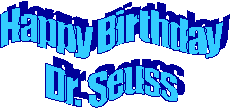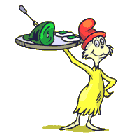 A unit by
Carolyn Hornik,
P.S. 101, Brooklyn, New York

Overview
On
March 2, 2004 we celebrate the one hundredth
birthday of Theodor Seuss Geisel, better known
as Dr. Seuss. Who doesn't love the silly cartoon
like characters and the amusing stories filled
with wonder and mischievous characters. Dr.
Seuss's stories fill young and old alike with
delight. Dr. Seuss enables us to see the world
not just as it is, but as we would like it to be.
He provides a view for children and adults that
is seen through the "wrong end of the
telescope" because, as Dr. Seuss proclaimed,
"nonsense wakes up the brain cells."
This
unit is a study on the life Theodor Geisel and
of the whimsical style of Dr. Seuss's writing and
illustrations. Students compare and contrast
stories, characters and illustrations in various
Dr. Seuss books and write a review of one of the
books read. The book reviews will be shared with
Ms. RoJene Willard's third grade students at the
Rochester Elementary School which is located
outside of Topeka, Kansas. Students create their
own illustrated rhyming stories modeling the
style of Dr. Seuss. Students write letters to Dr.
Seuss wishing him a happy Seuss Centennial in
which they describe their original stories.
|
